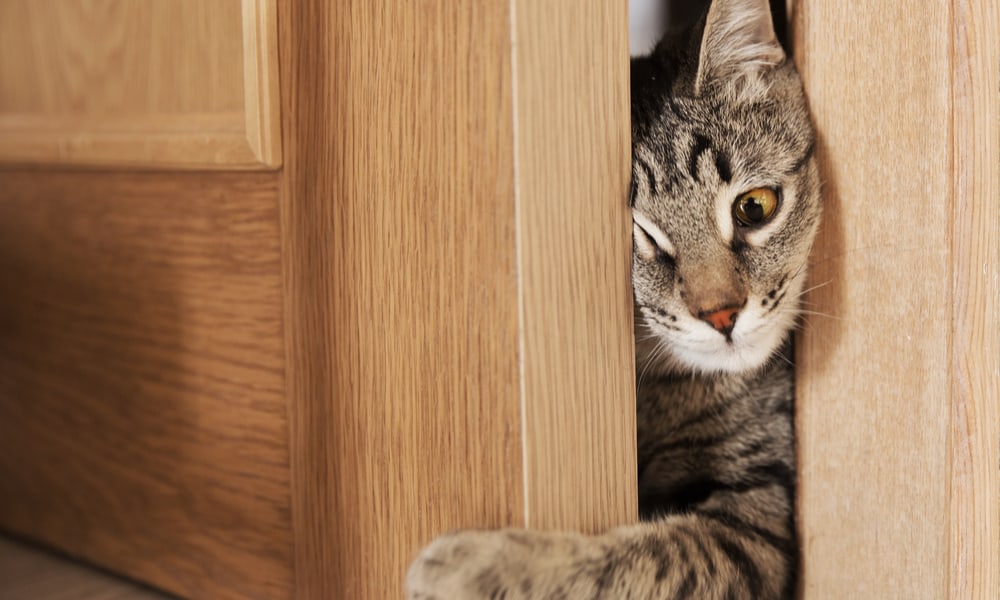As the emergency veterinary medicine team leader at BluePearl Veterinary Partners, Dr. Sonja Olson says she’s seen too many cats wind up in the emergency room with life-threatening injuries and health conditions that could have easily been prevented. In some cases, a few extra steps on the owner’s part could have saved the animal’s life.

While there will always be factors beyond our control, there are precautions we can take to protect our cats from sickness and stress, diseases, and dangerous situations. Here are 11 things you can start doing for your cat today to help her live a longer, healthier, and happier life.
Go to the Vet
Regular wellness exams and routine lab tests can help veterinarians find and treat many life-threatening health conditions before they become a problem. They’re especially important for cats, who are excellent at hiding when they’re sick or in pain, Olson says. Bringing your cat to the vet on a regular basis also ensures she’s up to date on all recommended vaccines, prescription flea and tick for cats and heartworm medicine for cats.
Don’t be afraid to shop around until you find a vet that you—and your cat—love, Olson says. Having a good relationship makes it easier for the doctor and staff to help your cat. They know her medical history and baseline temperament, and can usually tell with a phone diagnosis whether a strange new behavior necessitates immediate medical care.
Keep Your Cat Indoors
Keeping your cat indoors is one of the easiest ways to help her lead a long and happy life, Olson says. She’s less likely to be exposed to traumas, like being hit by a car, and toxins, like a tasty puddle of antifreeze. She’s also less likely to encounter disease-carrying pests and parasites. “When cats leave our home, we lose the ability to protect them,” Olson says.
That said, you have to make sure your house is a safe space for your cat. “Be careful with house plants,” warns Dr. Judy Morgan, a New Jersey-based holistic veterinarian. Some popular indoor plants, including lilies, are highly toxic, she says, so it’s best to consult a toxic plants list (e.g., ASPCA’s Toxic and Non-Toxic Plants List). “If your cat is craving greens, try growing wheat grass,” Morgan says. “Cats love it.” Pet grass gives kitties a safe alternative to potentially dangerous house plants.
During warmer months, you should also be cautious with cats around open windows. Keep window screens shut and ensure that they are secure enough that your cat won’t fall through them.
Feed Them Appropriately (and Watch Them Eat)
To help your cat live her best life, she needs a high-moisture, species-appropriate diet, Morgan says. Feed her wet and dry cat food, as kibble alone won’t do the trick. Morgan and Olson also stress that cats are natural carnivores who need plenty of meat in their diet.
If you have more than one cat, feed them separately and monitor each one’s consumption, Morgan says. Food avoidance could be a sign of dental pain or a medical condition. “Do not allow free-feeding,” she says. “This leads to weight gain and makes it less likely that you will notice problems right away.”
Watch Their Weight
An overweight cat is an unhealthy cat, the doctors agree. Carrying a few extra pounds can lead to a host of health conditions, including liver problems, diabetes, and arthritis. Being overweight also puts unnecessary stress on an animal’s joints and organs.
Feed your cat as recommended by your veterinarian. Exercise and playtime should also be a part of your cat’s daily routine, Morgan says.
Weigh your kitty once a month and call your vet if you notice any dramatic gains or losses, she says.
Encourage Mental Stimulation
In addition to helping her stay svelte, exercise and play can also prevent stress, resulting in happier and healthier cats, the doctors say. “Indoor kitties definitely live longer, but they need to be able to perform typical cat behaviors, like hunting, pouncing and interacting,” Morgan says.
Interactive play helps cats tap their natural instincts. Remember, they’re predators in the wild, Morgan says. “If you use something like a laser to play with your kitty, make sure to give them something tangible to ‘kill’ and ‘eat’ at the end of the chase.” Cat toy mice are a feline fave, as well as cat toy balls.
Other natural cat behaviors include climbing and scratching. Give cats plenty of horizontal and vertical play space with a cat tree. A cat scratching post can help them release stress while protecting your couch. Olson also recommends giving indoor cats a place to interact with nature, whether it’s a comfy cat window perch or an elaborate “catio.”
Want to stop your cat scratching at the door? We share with you a cat behaviorist’s insight into this common problem behavior
To stop your cat from scratching at the door, it’s important to first work out why they might be doing it. When you’ve provided all the best cat toys or scratching posts, spent lots of time with your feline friend, and made sure they’ve had their food… you might be frustrated, wondering what else do they need? Cats scratch for a range of reasons – this can be behaviourally anything from boredom to anxiety, or it can simply be down to the length of their claws.
While scratching is a common cat behavior it can be a nuisance for pet owners. The sound might be annoying – especially if it’s happening at night – or your cat might be damaging your doors. You might also be worried about your cat’s emotional welfare, wondering if they’re distressed.
So what do we do to stop our cats from scratching in the wrong place? We’ve enlisted the help of cat behaviourist Ruby Leslie to share with you nine top ways to stop your cat scratching and save your doors from further damage.
- Get your cat checked by your vet
Cats scratch to remove old nail sheaths, allowing room for new sharper nails. Your veterinarian can help you with your cat’s nail health and check to ensure your cat is overall physically well. Anxiety can be caused by ill-health so if your cat isn’t feeling good, they could scratch more. - Use pheromones and calming scents
If your cat is feeling stressed, spraying your doors or the surrounding areas with pheromone sprays or calming, cat-friendly scents can be a great way to help them feel more relaxed. It’s important to avoid using any scents that might deter your cat from going near the door as this could increase their feelings of stress. - Provide scratching posts
Cat Behaviorist Ruby Leslie suggests that you “Provide plenty of vertical and horizontal opportunities for your cat to scratch and encourage them to scratch there”. She recommends that you reward your cat with food when they scratch in these desired spots so that they’ll be more likely to scratch there instead of on your doors. - Get a pet camera
If your cat is only scratching the door when you’re not there with them, this may be a sign that they’re bored or anxious when alone. Filming them with a pet camera can be a good way to understand what they’re feeling as you’ll be able to look out for other behaviors such as meowing, pacing, or playing. - Mental stimulation
While we usually talk about training in relation to dogs, cats can just as equally benefit from a mental workout. Teaching your cat some simple tricks such as retrieving toys or giving you a high five, can help to tire them out mentally. A mentally tired cat is more likely to relax and sleep the rest of the day. - Playtime
Just as tiring your cat out mentally can be helpful, it’s also good for them to get a good physical workout. Never underestimate the importance of cat play – you can provide them with appropriate playtime using a cat wand or puzzle feeder toy. Regular play and exercise will help reduce the chances that your cat is scratching the door out or boredom. - Add a cat door
Your cat might be scratching your doors as a way to try and escape your home to roam or toilet outside. As Leslie says, “By adding in a cat door to your home, they have the freedom to come and go as they please”. - Be aware of neighborhood cats
If there are other local outdoor neighboring cats that roam close to your home, they could be causing your own cat some distress. Leslie adds that regularly using “Pheromones on your door can help to create calmness for your cat”. - Trim your cat’s nails
It might sound simple but just by keeping on top of your cat’s pedicures, you could save a whole lot of scratching. If your cat’s nails are too long, they may scratch more frequently to remove the nail sheaths – the older parts of their nails.



